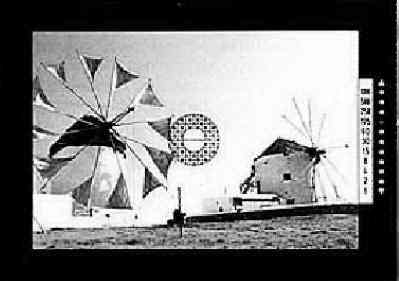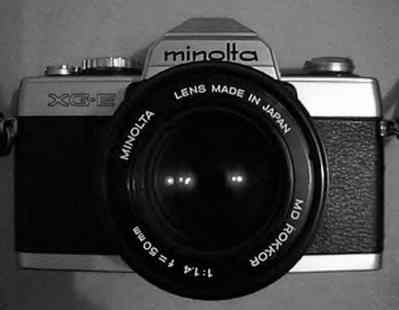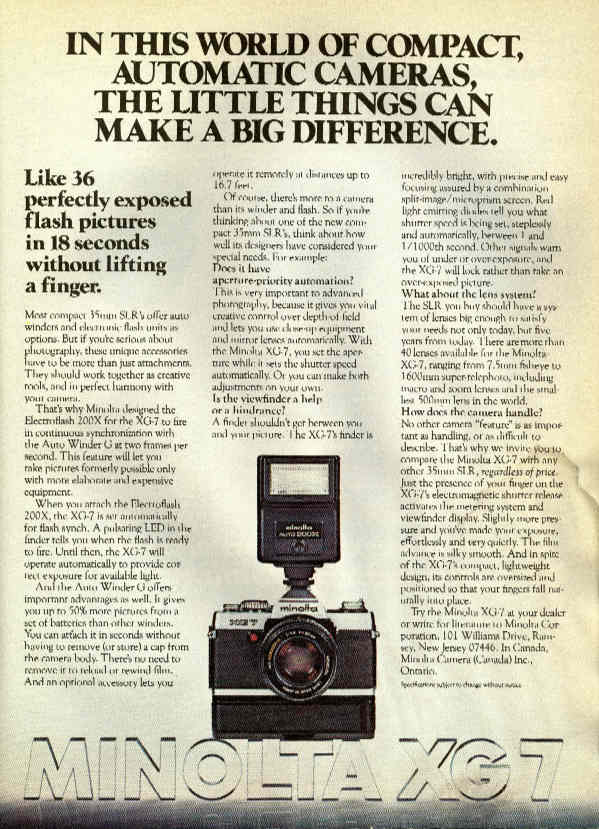

XG-7
(1977) Minolta knew that its new XD-11 camera was an expensive piece of equipment. Minolta's catalog listed the price for a chrome XD-11 with a 50mm f1.4 lens and case at $750. Few people would go for this. But the XD-11 was designed for the super serious amateur photographer who wanted the latest and greatest. But Minolta knew that in order to remain competitive it needed to produce a less expensive compact camera that retained the automatic exposure feature. This was the XG-7. It was produced at the same time as the XD-11, and had a very similar, compact body styling. The body styling is so similar, in fact, that many people think that the XG-7 and the XD-11 are the same camera -- with a few different features. But the XG-7 and the XD-11 are only similar at first glance. Although they might look like the same camera, the XG-7 is very different internally, and externally there are many differences as well. And it is these differences that make the XG-7 substantially less expensive than the XD-11.
Externally, the body on the XG-7 is almost exactly the same size, weight and shape as that of the XD-11, but look close and you'll see the differences. The XG-7 has a big, black block near the film rewind knob that the XD-11 lacks. This block controls several camera features. In addition, the XG-7 has a small ridge running along the front top that the XD-11 lacks. By now you'll notice more differences. The top edges of the XG-7 tilt slightly inward, the hot shoe is a little different, the film advance window is on the top (not the back), the film-speed setting window is on the right (not the left), the film rewind crank is different, the exposure compensation dial is on the right (not the left), even the film counter window is different. The only thing that is the same is the film advance lever. So much for using the same body. The controls are all there -- but moved around.
Then take an even closer look. A new feature on the XG-7 is the ON-OFF switch. The XD-11 is turned on by depressing the shutter release halfway. While some thought that this is more convenient than having a separate ON-OFF switch, as on the XE-7, it makes it all too easy to make an exposure unintentionally. Perhaps this is why Minolta opted for a more conventional ON-OFF switch on the XG-7. But they also made another change. The XG-7 introduced a new "Touch-Switch" to the shutter release. Turning the ON-OFF switch to the ON position, allows the shutter to release, but this doesn't turn the meter on, as it did with the XE-7. In order to activate the meter, the "Touch-Switch" needs to be touched. No pressure is needed, like in the XD-11, as the switch uses the natural conductivity of human skin to complete the circuit and turn on the meter. Minolta would use this "Touch-Switch" technology on most of its later cameras and the feature works well under most circumstances. But if your skin is very dry or you are wearing gloves, the circuit will not complete, so the XG-7 has a special activation switch. By depressing the shutter release slightly (similar to that in the XD-11), the meter is activated mechanically. Perhaps the best feature of this new system is that the XG-7 camera has an ON-OFF switch which prevents accidental exposures, unlike the XD-11.
But overall, the XG-7 has fewer features than the XD-11, making for a less-costly photographic package. First, the XG-7 lacks the shutter-preferred exposure mode of the XD-11. It operates on aperture-preferred and manual-exposure mode only, which meets the needs of most photographers. The XG-7 also saved money by swicthing to a more traditional, horizontal, cloth shutter. It's just as reliable as the metal shutter of the XD-11, but is not as quiet and has a slower flash X-synch speed (1/60). For most photographers this is not a big deal.
But there are some differences that make a difference. For example, the meter on the XG-7 turns off in manual exposure mode. Who had this innovative idea? We'll never know. It might be that this saved production cost, but that's hard to imagine. The other possibility is that Minolta marketed this for the photographically uninitiated. Perhaps they thought that by turning off the meter in manual mode that people would be forced to realize that the camera was no longer acting automatically. And this makes sense. If the camera were set at a manual shutter speed and the LED scale displayed a metered or recommended speed, the photographer could easily assume that the camera would take the picture at the speed displayed on the LED scale -- even though the shutter speed dial might be set at a different speed. The other alternative was to have a separate window in the XG-7 that displayed the manually-set shutter speed setting -- but this was an expensive proposition. Sure, it worked great in the XE-7 and the XK, but the cheaper alternative was to turn off the XG-7 LED scale in manual mode. It was cheaper than the alternatives -- a window for the set speed, or two LED scales -- one for the set speed and one for the metered speed. Minolta would have to deal with this dilemma for years to come, but it all started with the "cutting edge" LED scale of the XD and XG cameras. So much for progress.
Minolta didn't turn off the LED scale in the XD-11 in manual mode, but they assumed that XD-11 users were knowledgeable, and were less likely to be confused -- but then the expensive XD-11 displayed the manually set shutter speed in the viewfinder. To use the XG-7 in manual mode, you need to set it for automatic operation, take a reading and, then switch it back to manual mode.
Another cost-saving feature in the XG-7 is the lack of any non-battery-dependent shutter speeds. This means that in order to use the camera -- even manually -- it needs a battery. The shutter on the XD-11 -- and even earlier automatic cameras like the XE-7 and the XK -- is battery-dependent as well, but they all offer some mechanical speeds that can be used if the battery dies. You'll still be able to take pictures. But not the XG-7. It means that with the XG-7, you better always carry extra batteries -- that are fresh.
Another cost savings on the XG-7 was dropping the DOF/stop-down button. It was the first Minolta SLR with TTL metering to lack this feature. Despite the fact that most people call it a depth-of-field preview button, it was originally placed on the SRT101 to allow for stop-down metering, and not depth-of-field viewing. In fact, Minolta at first referred to it as a stop-down metering button. Back when the SRT101 was first produced, the new camera needed this feature to operate correctly with earlier, non MC (meter coupled), automatic diaphragm lenses. But by the time the XG-7 arrived on the scene, Minolta knew that very few users would have any of these older lenses. They also speculated that most photographers, especially those using a lower-tiered camera, would never use a DOF button. With both uses of the button no longer important, Minolta removed it and saved production costs.
Metering in the XG-7 also saw differences. The XD-11 was equipped with fast, but expensive silicon cell. In the XG-7, this was dropped in favor of a cheaper CDS cell. Fortuately, the cell is fast enough to keep up with the Autowinder and is only slightly less sensitive than the silicon cell. Another change on the XG-7 meter is that the film speed settings run from 25-1600, instead of the 12-3200 of the XD-11.
Even the viewfinder of the XG-7 is different from that of the
XD-11, even though they both used LED scales instead
of needles. The difference in the viewfinders was not just because the
XD-11 has multi-modes. In the XG-7, the shutter speeds
are displayed on a scale on the right-hand side of the viewfinder, but the
numbers are black on a clear background, similar to the
XE-7. In the XD-11, the
numbers are clear on a black background. In the XG-7, the automatically
selected shutter speed is displayed on the LED scale to the right of the
speeds. In the XD-11, the LED scale is on the
left of the speeds and partially protrudes into the picture. Also in
the XG-7, unlike in the XE-7 and
XD-11, the manually set f-stop is not displayed in
the viewfinder. Yet another cost savings on the XG-7 was reverting
to a conventional focusing screen. The XG-7 lacks the Acute Matte Screen
of the XD-11 so it is not quite as bright.

Other cost-cutting features of the XG-7 are that it lacks the soft, leatherette
exterior of the XD-11 and it cannot take multiple
exposures.
The XG-7 had many features that were the same, or at least similar to the XD-11. First, even though it was a budget camera, it accepts a motor drive, the Autowinder G. In many ways, this seems like one of the first features that should have been cut in order to reduce costs, but the autowinder feature was retained on this and all subsequent XG cameras even though most people never used it. The optional autowinder provides for exposures of up to 2 frames per second and is both small and lightweight. Some people who are used to the larger and heavier XE-7, prefer to use the XG-7 with the autowinder in place, just to make the lightweight camera more substantive in use. (The autowinder D looks the same as the Autowinder G but cannot be used on the XG-7. Neither can the later Motor Drive MD-1) Similarly, the XG-7 has a removeable back and an optional Data Back G -- another new feature that is unimportant to the budget-camera crowd. What was Minolta thinking? Useable with or without the autowinder, the Data Back G imprints dates or other infomation in the corner of the images.
Another similarity between the XG-7 and the XD-11 is that the XG-7 uses the same dedicated flash units as the XD-11. With one of Minolta's new X flashes, the correct shutter speed is automatically set when the unit is attached to the camera. No more need to manually change the shutter speed dial -- very convenient. And when the flash has reached full power, the 1/60 LED in the viewfinder blinks -- another nice touch.
The XG-7, like the XD-11, has a +/-2 EV exposure compensation dial, and a film memo holder on the back. The XG-7 saved some money by having a plastic cap for the viewfinder instead a built-in viewfinder shutter, and it has a new electronic self-timer with a flashing red light (which also served as a battery check), instead of the traditional, self-timer lever on the front of the camera. This was actually an improvement over earlier mechanical self-timers. In low-light or at quite a distance from the camera, you can clearly see the red, blinking, self-timer light of the XG-7. You know it's working.
Since the XG-7 lacks the shutter-preferred exposure mode, it does not require the use of the new MD Rokkor-X lenses. It will work fine with any of the older MC Rokkor-X and MC Rokkor lenses -- and even the older, Rokkor lenses. You can use the Auto-Rokkor lenses, but not in auto-exposure mode. These require manual mode operation, since you need a stop-down button to meter with automatic, non-meter-coupled lenses.
There were six models of the XG-7:






While many love the feel and operation of the XD-11, others find it overkill. If you don't need shutter-preferred exposure automation, the XD-11 probably isn't for you. That's why Minolta made the XG-7 at the same time. With the XD-11, you can end up paying more than you need to, for a camera that's much more complicated than you might need. Minolta made the XG-7 as the perfect alternative, but it was a short-lived camera, lasting only about one year. However it lived on in many later XG cameras, from the low-end XG-A to the high-end XG-M. Minolta quickly learned that there were many cameras hidden inside the XG-7. The XG-7 was merely the seed from which a large family tree of cameras evolved. The next year, 1978, Minolta split the XG-7 in two and produced the XG-1 and the XG-SE. For a comparative look at the major features of the XG-7 and its progeny, check out MINMAN's SLR table -- the world's most complete!

RETURN TO THE MANUAL
MINOLTA HOME PAGE We didin't want to do this, but since other websites
have been stealing our stuff, we have no alternative but to state:
COPYRIGHT@1995-2023 by Joe McGloin.
All Rights Reserved. The material on this website is protected by US Federal copyright laws. It cannot be copied or used in any manner without specific approval from the owner.
The material on this website is protected by US Federal copyright laws. It cannot be copied or used in any manner without specific approval from the owner.